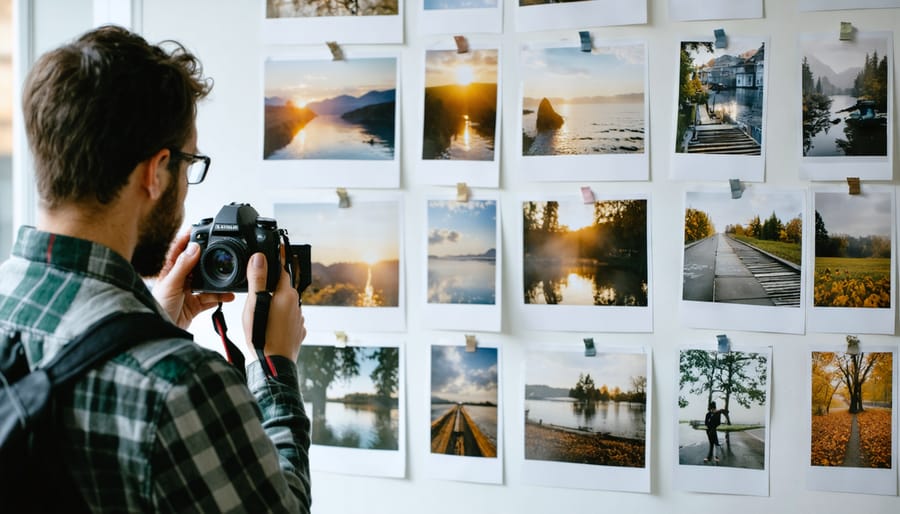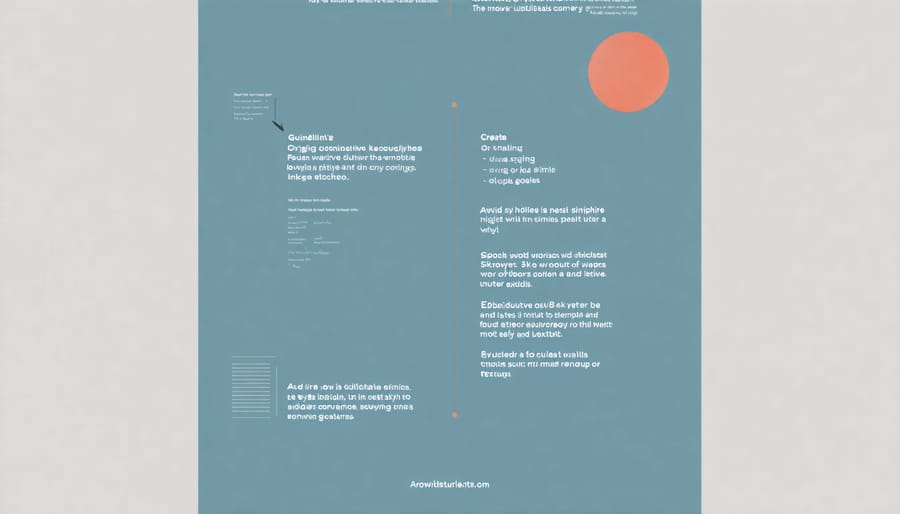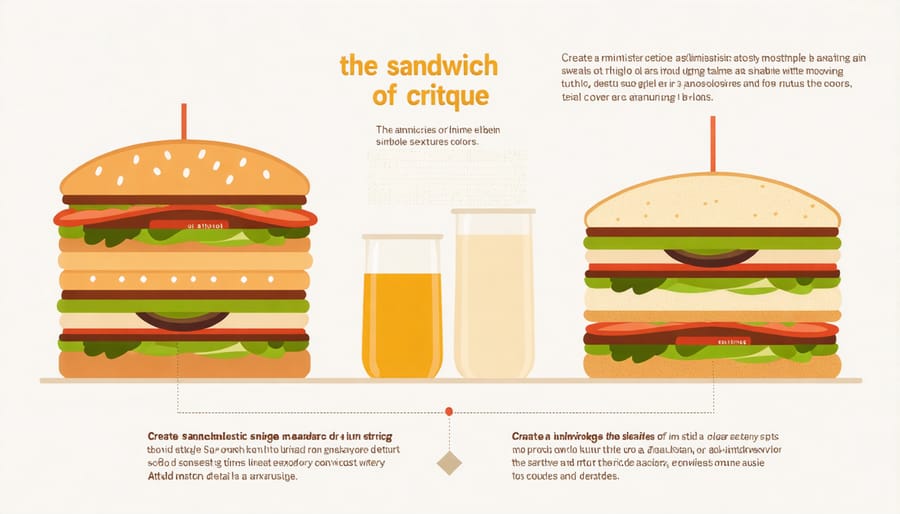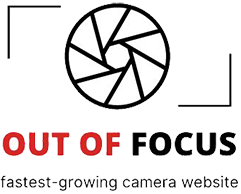
Photography critiques transform good images into exceptional ones, serving as a vital bridge between technical skill and artistic vision. Every masterful photograph you’ve admired has likely undergone countless rounds of thoughtful feedback, refinement, and iteration.
Step into any professional photographer’s journey, and you’ll find critique circles played a pivotal role in their development. These structured feedback sessions offer far more than casual comments or social media likes – they provide detailed, actionable insights that push photographers beyond their comfort zones and challenge their creative assumptions.
Whether you’re capturing landscapes, portraits, or street photography, understanding how to give and receive constructive criticism becomes as essential as mastering your camera settings. The most valuable growth often happens not in the moment of clicking the shutter, but in the careful analysis that follows.
Yet many photographers shy away from critiques, fearing harsh judgment or misunderstanding. The reality? A well-structured critique environment creates a supportive space where artists can explore their strengths, address their weaknesses, and discover new perspectives they might never have considered on their own.
In this guide, we’ll explore how to navigate photography critiques effectively, ensuring you get the most value from both giving and receiving feedback in this vital aspect of photographic growth.
Why Join a Photography Critique Circle?
Learning Through Others’ Eyes
Receiving feedback from diverse perspectives can dramatically accelerate your growth as a photographer. Whether through online communities or in-person critique sessions, each viewer brings their unique interpretation and technical expertise to your work. This variety of viewpoints helps you identify blind spots in your technique that you might have missed on your own.
Much like expert mentorship in photography, critique circles expose you to different artistic approaches and technical solutions. A landscape photographer might offer insights about composition that you hadn’t considered for your portrait work, while a commercial photographer could suggest lighting techniques that elevate your street photography.
The beauty of learning through others’ eyes lies in the unexpected discoveries. What you might consider a minor flaw could be the first thing an experienced photographer notices, helping you refine your technical execution. Conversely, elements you overlooked might be praised as powerful artistic choices, encouraging you to develop these strengths further. This collaborative learning environment helps you build a more comprehensive understanding of both the technical and artistic aspects of photography, ultimately leading to more intentional and impactful images.

Building a Supportive Network
Building a strong support network in photography is essential for growth and continuous improvement. By connecting with fellow photographers, you create opportunities for learning from photography experiences that extend beyond technical skills into creative exploration and professional development.
Start by joining local photography clubs or online communities where critique sessions are regular activities. These groups often become more than just feedback circles – they transform into mentorship opportunities and collaborative networks. Look for communities that match your photography interests and skill level, whether that’s landscape, portrait, or street photography.
Social media platforms like Instagram and dedicated photography forums can be excellent starting points, but don’t overlook in-person meetups and workshops. These face-to-face interactions often lead to deeper connections and more meaningful critique relationships. Consider organizing regular critique sessions with a small group of trusted photographers who share your commitment to growth.
Remember that building a supportive network takes time and active participation. Contribute regularly, offer thoughtful feedback to others, and remain open to different perspectives. This reciprocal relationship creates a nurturing environment where everyone benefits from shared knowledge and experiences.
Getting Meaningful Feedback
Presenting Your Work Effectively
When sharing your work for critique, presenting visual content effectively is crucial for receiving meaningful feedback. Start by selecting your strongest images – quality over quantity is key. Three to five photographs allow critics to focus their attention and provide detailed insights without feeling overwhelmed.
Include essential technical details with each image: camera settings, lighting conditions, and any post-processing techniques used. This context helps critics understand your creative decisions and technical approach. However, avoid lengthy explanations that might bias viewers’ initial impressions.
Consider creating a brief artist statement that outlines your vision, intended message, or specific areas where you’d like feedback. For example, if you’re struggling with composition in street photography, mention this to guide critics toward providing relevant suggestions.
When sharing digital images, ensure they’re properly exported at an appropriate resolution for web viewing while maintaining enough detail for meaningful critique. If you’re sharing prints in person, mount them professionally or present them in a portfolio that allows for easy viewing.
Remember to specify whether you’re seeking general feedback or targeting specific aspects like composition, technical execution, or emotional impact. This helps critics tailor their responses to your needs and ensures you receive the most valuable feedback for your growth as a photographer.

Asking the Right Questions
When seeking feedback on your photography, the way you frame your request can make all the difference in the quality of responses you receive. Instead of simply asking “What do you think?” try to focus your questions on specific aspects of your work that you want to improve.
Start by identifying particular elements you’re uncertain about. For instance, “Does the composition lead your eye through the image effectively?” or “Is the lighting on the subject’s face too harsh?” These targeted questions help critics provide more meaningful feedback rather than generic comments.
Consider breaking down your request into technical and artistic components. On the technical side, you might ask about exposure, focus accuracy, or color balance. For artistic elements, seek feedback on mood, storytelling, or emotional impact. For example: “I was trying to convey a sense of isolation in this street photograph – does the composition and lighting support this intention?”
It’s also helpful to provide context about your creative decisions. Share what you were trying to achieve, the challenges you faced, and any specific techniques you used. This background information allows critics to evaluate your work within the framework of your intentions.
Remember to be specific about the type of feedback you’re looking for – whether it’s suggestions for improvement, technical advice, or creative direction. This clarity helps ensure you receive the most valuable and actionable critiques for your continued growth as a photographer.
Giving Constructive Criticism
The Sandwich Method
The Sandwich Method is a tried-and-true approach to delivering balanced, constructive photography critiques that maintain positivity while fostering growth. This technique involves structuring your feedback in three layers: starting with positive observations, followed by constructive suggestions, and concluding with encouraging remarks.
Begin by highlighting what works well in the image. Perhaps it’s the compelling composition, beautiful lighting, or expert timing. Be specific about these strengths – instead of saying “nice photo,” explain why the photographer’s choice of a low angle made the subject more dramatic, or how their use of leading lines draws the viewer’s eye effectively through the frame.
The middle layer addresses areas for improvement. Frame your suggestions as opportunities rather than failures. For example, “The background might be less distracting if shot at a wider aperture” is more constructive than “The background is too busy.” Always provide actionable advice that the photographer can apply in future shoots.
Close your critique by reinforcing the image’s strengths and expressing enthusiasm for the photographer’s potential. This final positive layer helps ensure the recipient remains receptive to the feedback while feeling motivated to continue developing their skills.
Remember that the goal isn’t to sandwich harsh criticism between compliments, but to create a balanced, honest dialogue that encourages growth while maintaining respect for the photographer’s creative vision.

Being Specific and Actionable
When providing critique, vague comments like “nice photo” or “needs work” don’t help photographers improve. Instead, focus on specific elements and offer actionable suggestions. For example, rather than saying “the composition is off,” explain: “Moving the subject slightly to the left would create better balance and align with the rule of thirds.”
Break down your critique into clear components: exposure, composition, lighting, color balance, and technical execution. If you notice overexposed highlights in a landscape photo, suggest specific techniques like using graduated neutral density filters or bracketing exposures for HDR merging.
When addressing post-processing, provide step-by-step recommendations: “To enhance the subject’s eyes, try using a small radial filter with +0.3 exposure and +10 clarity.” This gives photographers concrete steps they can implement immediately.
Include both technical and artistic observations. For instance: “The shallow depth of field creates beautiful bokeh, but considering the environmental context of this portrait, stopping down to f/4 would help include more detail in the meaningful background elements.”
Remember to reference specific areas of the image: “The dark shadow in the bottom-right corner draws attention away from the main subject. Consider brightening this area during post-processing or adjusting your lighting setup to eliminate deep shadows in future shoots.” These precise suggestions give photographers clear direction for improvement while maintaining a constructive, supportive tone.
Popular Photography Critique Platforms
Moderated vs. Open Forums
When seeking photography critiques, you’ll typically encounter two main types of platforms: moderated and open forums, each offering distinct advantages for different photographers’ needs.
Moderated forums provide a structured environment where feedback is carefully curated and monitored by experienced photographers or community managers. These spaces often maintain higher quality standards and enforce specific critique guidelines, making them ideal for serious photographers seeking substantive feedback. You’ll typically find more detailed, constructive comments and a lower risk of unconstructive criticism or trolling.
Open forums, while more casual, offer greater accessibility and immediate engagement. These platforms can be particularly valuable for beginners who want to dip their toes into sharing their work. The democratic nature of open forums often leads to diverse perspectives and can expose photographers to viewpoints they might not encounter in more controlled environments.
Many photographers find success by participating in both types of communities. For instance, you might share your experimental work in open forums for quick feedback, while reserving your portfolio pieces for moderated spaces where you’ll receive more detailed technical analysis. As virtual photography communities continue to evolve, some platforms have begun incorporating elements of both approaches, offering tiered feedback systems that combine the accessibility of open forums with the structured guidance of moderated spaces.
Consider your current skill level and feedback needs when choosing between these options. Moderated forums typically require more commitment and may have posting requirements, while open forums offer more flexibility but might require additional effort to filter through less relevant feedback.
Choosing the Right Community
Selecting the right photography critique community can significantly impact your growth as a photographer. The key is finding a group that aligns with your goals, experience level, and preferred photography style. Consider communities that specialize in your primary interests, whether that’s landscape, portrait, street photography, or another genre.
Experience level matching is crucial. If you’re a beginner, look for communities that welcome newcomers and offer constructive, encouraging feedback. More advanced photographers might prefer groups with experienced members who can provide detailed technical analysis and professional insights.
The community’s activity level and response time matter too. Active communities with regular participation tend to offer more valuable feedback, but ensure the pace matches your own engagement capabilities. Some photographers prefer daily interaction, while others might want weekly or monthly critique sessions.
Consider the community’s feedback style. Some groups focus on technical aspects like composition and exposure, while others emphasize artistic vision and emotional impact. The best communities often balance both technical and creative feedback.
Platform choice is another important factor. Online forums offer convenience and global reach, while local photography clubs provide face-to-face interaction and networking opportunities. Social media groups can be accessible but may offer less structured critique formats.
Look for communities with clear guidelines and moderation. Well-moderated groups typically maintain a more respectful, professional atmosphere and ensure feedback remains constructive. Pay attention to how current members interact – this often indicates the community’s overall culture and whether it will be a good fit for your needs.
Remember, you can belong to multiple communities, each serving different aspects of your photographic journey. Start by observing the interaction style and feedback quality before actively participating.
Photography critiques are an invaluable tool for growth in your creative journey, offering fresh perspectives and insights that can dramatically improve your work. Throughout this guide, we’ve explored the essential elements of meaningful critique, from understanding constructive feedback to mastering the art of delivering it effectively.
Remember that participating in critique circles isn’t just about receiving feedback – it’s about building relationships within the photography community and contributing to others’ growth as well. The skills you develop in analyzing and discussing photographs will enhance your own artistic vision and technical understanding.
Whether you choose to join an online photography forum, a local camera club, or a professional critique group, the key is to remain open-minded and engaged. Start small if you’re feeling hesitant – perhaps by sharing one image and focusing on giving thoughtful feedback to others. As your confidence grows, you’ll find yourself naturally becoming more involved in these enriching discussions.
Don’t forget that every photographer, from beginners to professionals, can benefit from critique. The perspectives you gain from others’ experiences and interpretations can lead to breakthrough moments in your creative development. Take that first step today – join a critique circle, share your work, and become part of this supportive community of passionate photographers. Your growth as an artist awaits.





















